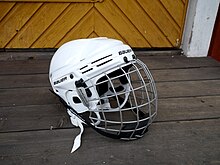Ice hockey helmet
An ice hockey helmet is a helmet that is part of protective equipment in ice hockey and inline hockey to protect against injuries . It consists of very stable materials. The helmet shell is made of ABS plastic and is adjustable in length, inside there is a multi-part padding made of hard foam.
A grille or visor is fixed with screws as a face protection . The grid is compulsory in the junior and women's area and compulsory in the men's area. The visor offers better visual properties, but also tends to fog up, so that anti-fogging agents are necessary. There are also combinations of visor and grille. Wearing a grille also reduces the risk of concussions and virtually eliminates tooth damage. The helmet can provide little protection against the consequences of a lack of anticipation on the part of the player, for example through a lowered head.
Usually, ice hockey helmets have a maximum usage time of around 10 years. The requirements are also laid down in various European and American standards, such as B. EN ISO 10256: 2003 ("Head and face protection")
Ice hockey helmets have been around since the late 1920s, but they didn't become mandatory in the U.S. until 1979.
The ice hockey helmet is not to be confused with the goalie mask .
Individual evidence
- ↑ https://www.sicherheit.sport/wp-content/uploads/2015/01/fi_sportunfaelle_profieishockey_sportvereine.pdf p. 32
- ↑ Communication from the Commission in the context of the implementation of the Council Directive 89/686 / EEC on the approximation of the laws of the Member States relating to personal protective equipment (PDF)
- ↑ https://www.corvin-mueller.com/eishockey/history/helm-1/

